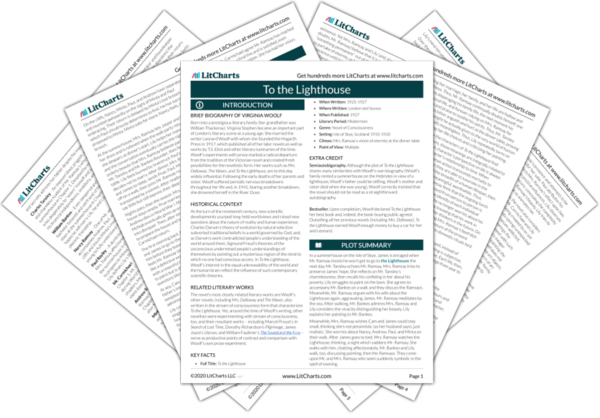Summary
Analysis
Standing on the lawn with Mr. Ramsay striding about and Mrs. Ramsay reading at the window, Mr. Bankes and Lily discuss the Ramsays. Mr. Bankes laments that Mr. Ramsay isn’t even-tempered while Lily defends his childlike self-absorption, calling it honest, undeceiving. She only takes issue with “his narrowness” and “blindness.” Mr. Bankes,’ thinking of his own empty house, suggests Mr. Ramsay is a kind of hypocrite, hoping Lily will agree.
Lily sees some virtue in the volatile egotism that Mr. Bankes criticizes in Mr. Ramsay: because of it, Mr. Ramsay never hides what he is thinking and always shows his feelings on his face. Mr. Ramsay’s interior reflection on his own life’s circumstances affects his exterior comment on Mr. Ramsay’s personality.
Themes
Quiz
Test Yourself
Before answering, Lily considers Mr. and Mrs. Ramsay, feeling it is only possible to discuss them when they are out of sight for, once one saw them, they “became part of that unreal but penetrating and exciting universe which is the world seen through the eyes of love. The sky stuck to them; the birds sang through them” and all of life’s “little separate incidents…became curled and whole like a wave” carrying one and delivering one to the shore.
For Lily, Mr. and Mrs. Ramsay’s marriage functions like a classical work of art: it invigorates the viewer’s perspective with its energy and beauty and unifies the seeming chaos of life’s randomness into a deliberate aesthetic shape. Yet if that shape is a wave, it is an image containing only the sea’s beauty and rhythm without the sea’s terrifying reminder of mortality.
Themes
Literary Devices
Quiz
Test Yourself
Then, as Lily is about to answer Mr. Bankes with a criticism of Mrs. Ramsay, she notices that Bankes is gazing at Mrs. Ramsay in utter “rapture,” “love that never attempted to clutch its object” like a mathematician’s love for math or a poet’s for poetry: a love “meant to be spread over the world and become part of the human gain.” Lily feels hugely grateful for and consoled by Mr. Bankes’ “rapture,” exalted “that people should love like this.” She, too, “felt…praised” by his gaze which was shared among all women.
Lily sees a link between the admiration for human beauty and the admiration for non-human beauty. She perceives in Mr. Bankes’ gaze the sort of unselfish appreciation that other people have for non-human beauty (mathematics or art). Because his love is unselfish, Lily feels she, too, can participate in it, admiring the admiration and sharing its praise with all womankind.
Themes
Quiz
Test Yourself
Lily turns to look at her painting and is thrown into despair. She remembers Mr. Tansley’s opinion that women can neither paint nor write. She remembers she was going to criticize Mrs. Ramsay, and looks up to try to discern the specificity of Mrs. Ramsay’s person within her beauty, whose “setting…was always…hasty, but apt.” She recalls Mrs. Ramsay’s vivacious insistence the night before that Lily and Minta marry, for marriage was “the best of life.” Lily had felt her own unmarried life caring for her father and “even, had she dared to say it,…painting” rendered smaller and sadder by Mrs. Ramsay’s insistence. She had laid her head in Mrs. Ramsay’s lap and yearned to be made one with Mrs. Ramsay by the force of love so that all of Mrs. Ramsay’s private knowledge and wisdom could be shared by her too.
By referring to its “setting,” Lily describes Mrs. Ramsay’s beauty as if it were a piece of jewelry or an artwork (a manmade beauty). For Mrs. Ramsay, the meaning of life lies in marriage, procreation, and homemaking. But Lily feels her own life belittled by this perspective and is unsure whether she can find meaning in the thing she so values: her painting. Bewildered, Lily longs for Mrs. Ramsay’s confidence about life’s meaning.
Themes
Literary Devices
Quiz
Test Yourself
Get the entire To the Lighthouse LitChart as a printable PDF.

Lily braces herself as Mr. Bankes turns to examine her painting, feeling that he is seeing “the residue of her thirty-three years, the deposit of each day’s living, mixed with something more secret than she had ever spoken or shown.” He asks her about the abstraction and shadows and Lily explains that it is both “of” and “not of” Mrs. Ramsay and James, talking about the painting in terms of form. To her delight, Mr. Bankes is genuinely interested and she fills with gratitude to Mr. and Mrs. Ramsay “and the house and the place” for the sudden “exhilarating” feeling of companionship with Mr. Bankes.
For Lily, art is integrally related to life—she sees her entire existence embodied in her painting. Lily’s explanation of her painting describes the middle ground inhabited by art: an artwork seeks to loyally represent life while it also seeks to transform that representation into something new. Lily is delighted that she can share her interior life with Mr. Bankes and that he seems to understand and appreciate it.
Themes
Quiz
Test Yourself












